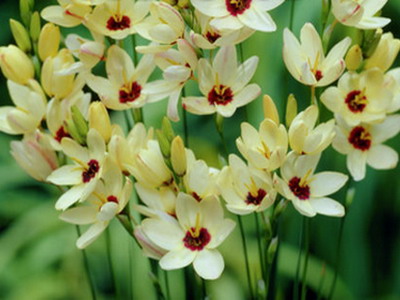For most flower growers, growing plants is not only a useful pastime or hobby. Making an alpine hill, rockery or mixborder on their site, amateur gardeners turn their site into a real masterpiece. Ixia, a tropical flowering plant, is great for creating amazingly beautiful “green” works of art.

Ixia in the photo
Decorative ixia takes root well in the open ground of the middle and southern regions of Russia. Ixia, the planting of which depends on the region, subject to simple rules, will please with its fragile tropical charm and South African exoticism in the first year.
Reproduction of garden ixia
For reproduction, large healthy corms with well-developed eyes-buds and rudiments of roots are used. Before planting an ixia, it is imperative to view all planting material for the presence of mold and fungi.

Reproduction of ixia in the photo
You can plant both whole healthy bulbs and “delenki”. For this, a large corm is cut into several parts (2-3). You need to cut so that each part has a kidney and spine. After that, each cut is treated with ash or charcoal.
How to plant ixia?
Despite the fact that this tropical flower is little exposed to diseases, it is still recommended to plant it every year in a new place. A sunny, windless area away from trees is a great place to plant a Tropican. The soil is selected without stagnant water, nutritious, rich in humus, with a neutral level of acidity.
Once a landing site has been selected, it must be well prepared. To do this, the proposed place must be loosened or dug up, composted and mixed. If the soil is too heavy, add sand for better water permeability.
If there is confidence that the ixia bulbs will be able to survive the winter in the ground, then you can plant them before winter, around November. It is necessary to plant as late as possible so that the ixia does not have time to germinate. For such a planting, you need to take whole, large, mature and healthy bulbs. Delenki should not be planted, as their tender buds cannot survive even a warm winter.
When to plant ixia?
When to plant ixia in spring depends on the climate and air temperature. Most often, this should be done in May. Otherwise, being late with the landing, and waiting for a temperature of +7 ° C, the sprouts will be weak, or even die.
During spring planting, corms, delenki or children are planted in pits to a depth of 5-8 cm. Loose soil is first poured into the bottom of the pits, special fertile soil or soil mixture can be used. The distance from hole to hole is 8-12 cm (for children), 10-20 cm (for corms).

This year, only large bulbs will bloom, all the rest – in 1-2 years. If the bulb is soft and has the first signs of mold, it is not worth planting – it will most likely rot. After planting the ixia, the ground is slightly mulched, no more than 2-3 cm.
You don’t need to water right away. If healthy planting ixia is used, growing the most beautiful tropical flowers on your site will not be difficult and burdensome.
Growing and caring for ixia
After planting, the plant is not watered for several weeks. And only after the first sprouts appear, usually after 2-3 weeks, they provide optimal watering, which is constantly increasing. During budding and during the flowering period, ixia is watered abundantly, preferably using special complex preparations that improve flowering processes.
Top dressing is desirable in the form of mineral fertilizers, which can be alternated with organic ones. Today, there is a wide range of fertilizers and top dressings for bulbs on sale, with which you can “feed” ixia. If necessary, dried inflorescences are removed. With the end of flowering, watering also stops. And after drying all the leaves, the bulbs are dug up for winter storage.
When growing garden ixias, wilting of the leaves of the plant may occur, which is associated with a lack of moisture. Therefore, it is necessary to ensure that the soil does not dry out even for a day. However, excessive moisture can cause mold to grow on the bulbs. To prevent this, before planting ixia, it is necessary to provide drainage and treat the bulbs with a fungicide.
Outdoors is not the only way to grow a beautiful tropical plant. If you wish, you can try to grow a “tropican” in closed ground. Ixia care in this case will be harder.
You can try to grow a flower as a forcing culture. But there are 2 nuances: you need good lighting with a 16-hour day and a relatively low temperature. To ensure optimal lighting, a phytolamp may be needed. If you use a DNAT lamp for these purposes, then you need to take 60 watts of power. Good lighting is the key to lush flowering.

The temperature is initially maintained at +3-7 °C, and then +10-13 °C. Given this, we can conclude that the flower is more suitable for a subtropical winter garden or a cold greenhouse than for a living room. By planting bulbs in December-January, in early March, you can get a flowering tropical plant. The amount of watering and top dressing is the same as when planting in open ground.
Ixia storage
After the foliage of the plant has withered, the bulbs are dug up, dried, disinfected in potassium permanganate (“potassium permanganate”) and dried again. Can be wrapped in newspaper and stored in a warm, cool place.

Ixia storage in the photo
The best place for this is the refrigerator. Sometimes the flowers are transplanted into pots for the winter. Naturally, the plant will remain exactly like this until spring, but during the winter it will grow and by the time the budding is budding, the plant does not have the strength to do so.







